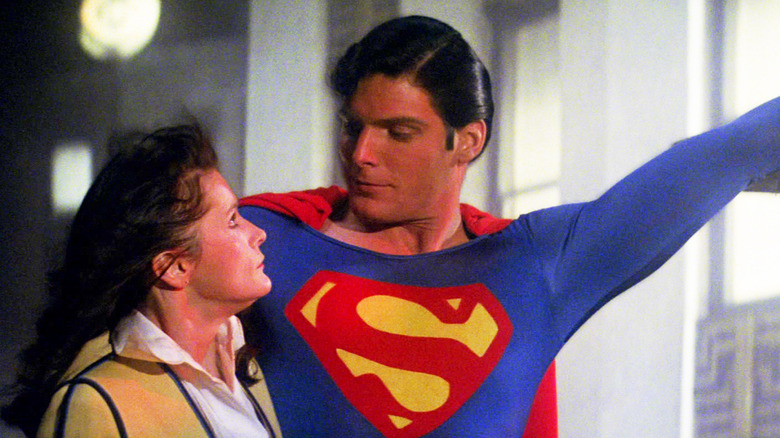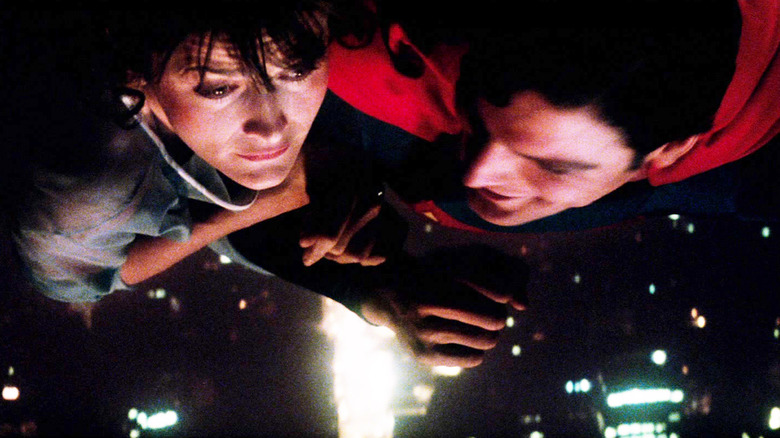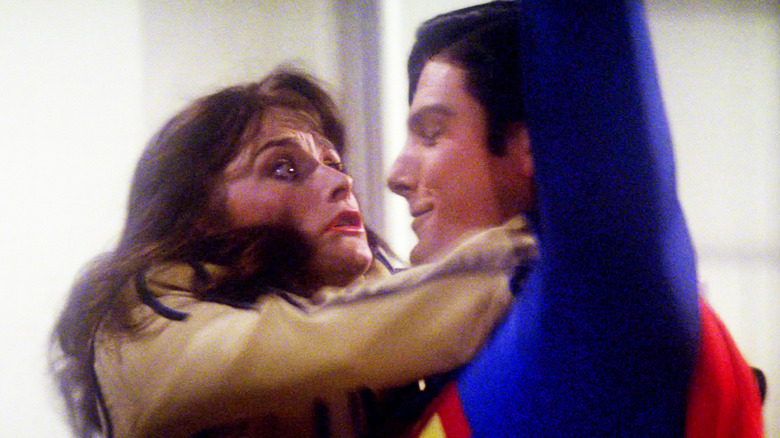Superman's Flying Scenes Were Brutal On Both Margot Kidder & Christopher Reeve
There's not much you can say about 1978's "Superman" that hasn't already been said. The film's legacy as defining the modern blockbuster and creating a blueprint for superhero movies going forward is well established. Treating its subject matter with respect and dignity while maintaining just enough of a light-hearted tone to keep things entertaining for everyone, "Superman" betrays none of the behind-the-scenes turmoil that director Richard Donner endured to bring the movie to the big screen.
Having been convinced to direct by producer Alexander Salkind with the promise of a "perfect" script, the filmmaker quickly found that he would have to make major changes to the screenplay in order to deliver a movie that wasn't several hours long and didn't treat Superman as some sort of joke. And that was just the start of the problems, with Donner ultimately revealing that shooting "Superman" was the toughest two years of his life.
But it wasn't just the director that suffered to make "Superman" into the beloved comic book adaptation it eventually became. Margot Kidder may have been charming as Lois Lane, but the star had to endure a pretty arduous shoot schedule that saw her working 14 hour days. What's more, the scenes that involved her being flown around by Christopher Reeve's Superman sounded like a real pain — literally.
Making Superman fly
Just like most things behind the scenes of "Superman," getting the flying scenes right was a protracted struggle. Initial tests had proven unusable, so Richard Donner had to work with his crew to develop new ways of delivering on the film's famous tagline: "You'll believe a man can fly." Ultimately that involved using a combination of wire work, hydraulics, and a newly-developed front projection unit created by VFX artist Zoran Perisic. Of course Alexander Salkind wouldn't pay to finish development on this unit so Donner could use it, forcing the director to turn to Warner Bros., who graciously put up the cash.
But even once the techniques and methods had all been figured out, that didn't mean actually shooting the scenes was easy, especially for the actors. As creative supervisor and director of special effects, Colin Chilvers, told VFX Voice, the rig built to get Reeve airborne was basically a hydraulic gimbal with a fiberglass tray attached that was molded to the actor's body. Chilvers continued:
"For the camera, we slung it on a counter-weighted wire so that the camera and the front-screen projector could move from side to side and up and down, which effectively made it look like Chris was moving from side to side and up and down."
Other flying scenes were accomplished using wire work and a "seesaw-like contraption" which Reeve would be propelled from by having "a couple of burly guys" jump on the other end. Thankfully, Reeve didn't seem to mind contending with these contraptions and basically saved Superman's flying scenes due to his experience as a pilot informing his movements. Margot Kidder, on the other hand, did not have such an easy time.
'Take after take after take'
In a behind-the-scenes documentary you can witness poor old Margot Kidder, strapped into what looks like a corset and diaper attached to a wire, being swung around the "Superman" set. Which, believe it or not, wasn't the most pleasant experience. According to Kidder, not only was it physically uncomfortable, the compounding factor was having to shoot the same thing over and over again. As she put it:
"The most grueling parts of it were, obviously for Christopher and I, the flying scenes, which were physically so uncomfortable and often downright painful. And tedious. And take after take after take."
Her co-star Christopher Reeve also spoke about how the pair often "landed short of the building," adding: "other times they'd drop us too late, so we came and we kind of went bouncing into the kitchen." That didn't help when it came to limiting the actors' time in their harnesses. And on top of that, Kidder revealed that she'd finish her "14, 15-hour day," before being driven back to London, near where production was taking place, taking a quick rest and then "get[ting] up again and stagger[ing] back on the set."
Kidder would later speak about the experience at WonderCon 2015 (via Collider), saying, "If you're hanging in a harness for 14 hours a day for weeks and weeks, your ... pelvic area will become sore." The actor, who sadly passed away in 2018, also recalled how at one point, "some kid dropped his clapperboard on the wire," causing her and her co-star to drop rapidly toward the floor before being caught. But hey, at least the movie won a Special Achievement Academy Award for Visual Effects, so Kidder's suffering wasn't entirely in vain.


